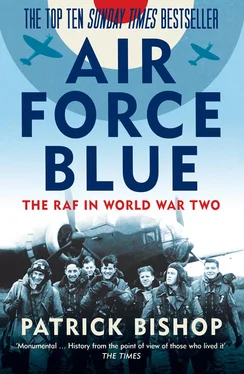In Q-Queenie, rear gunner Fred Whitfield sat in his turret and waited with the rest of the crew for their turn. After thirty operations together they knew each other as well as they did their own families. They were ordinary men from all over Britain. The pilot, Ron Adams, came from Wembley, London, Larry Brown the flight engineer was from Leeds, bomb aimer Phil Jackson from Nottingham, navigator Jim Lynam from Scunthorpe, wireless operator Jack Faucheux from Romford and the mid-upper gunner Frank Stebbings from Tunbridge Wells. Fred Whitfield was a Geordie, born in South Shields.
Starting operations in the aftermath of D-Day, they had bombed V weapons sites, marshalling yards, bridges and U-boat pens, before resuming the assault on German cities. They had been shot up by a night fighter and only made it home thanks to the skill and determination of ‘Lucky’ Adams who, though only twenty-one, was in Whitfield’s eyes ‘the best pilot in the RAF’. The gunners gave as good as they got. Whitfield and Stebbings had several kills to their credit, and the crew’s ‘press-on’ spirit had earned them four Distinguished Flying Medals and one Distinguished Service Cross between them. It had needed courage, skill and the closest teamwork to come through these trials and their faith in each other was strong. The raid they were about to embark on seemed less hazardous than most. But everyone knew of a crew that had bought it on their last mission. While he waited Whitfield ‘closed my eyes for a couple of minutes and had a few words with my God’.8
Then Q-Queenie was shuddering with the pent-up kinetic energy of four Merlin engines as Ron Adams jammed on the brakes and opened the throttle to maximum revs. He eased off and the Lancaster bounded forward. At about 50 knots (57mph) Whitfield ‘felt the turret lift as the tail wheel left the ground. “90 knots, 100 knots, 120 knots,” said the engineer, reading the speed. The skipper eased back on the control column. Queenie was airborne. We climbed, slowly gaining height.’
Once all aircraft were at 10,000 feet they formed a loose gaggle, and set course for Cap Gris Nez near their rendezvous with the squadron with whom they would be spearheading the raid. 617 Squadron were friends and rivals and their base was only a few miles from Bardney at Woodhall Spa. The two operated together often, specializing in missions requiring great skill and accuracy, and as Brian Bliss reminded his listeners six months before had finished off Hitler’s last remaining battleship with a volley of ‘earthquake’ bombs as she lay crippled in Tromsø fjord. The exploit had added extra lustre to the reputation of 617, already famous as the Dam Busters. However, as their sister squadron liked to point out, they were relative sprogs in the bombing game, having been created only two years earlier, whereas 9 Squadron dated back to 1914 and had been in continuous action from the very start of the war.
The sister squadrons made up just a small part of a huge force bearing down on Berchtesgaden. The pre-dawn sky of eastern England was thick with aircraft heading in the same direction. Three hundred and fifty-nine bombers were being thrown into the attack. Guiding them were sixteen Mosquitoes from Path Finder Force, equipped with special navigation aids to fix the target, tucked, safely until now, in the folds of the Bavarian Alps. Only five years before, an armada of this size was a distant fantasy. Yet this was not even the biggest raid of the day. An even larger formation was heading off to the North Sea island of Wangerooge, to smash up shore batteries that menaced Allied shipping delivering supplies to the port of Bremen for the armies encircling Berlin.
The RAF of April 1945 bore little resemblance to the organization Jim Bazin had joined eleven years before. In that time it had expanded enormously, evolving from a tight, professional elite drawn mainly from the top layers of society into a vast structure, more than a million strong. It had long ceased to be an overwhelmingly British enterprise. Scattered among the squadrons today were Poles, Australians, New Zealanders, Rhodesians, Americans, Canadians, Frenchmen and Dutchmen, Norwegians and Danes, only some of the sixty nationalities which had found a home in the Air Force.
The spirit of amateurism that still flickered in the pre-war service had long ago been snuffed out by the demands of war and replaced by a ruthless professionalism. Five years and eight months before, 9 Squadron had taken part in the first proper British air raid of the war. On 4 September 1939, together with 149 Squadron, they flew in appalling weather across the North Sea to attack German warships lying near Brunsbüttel. They had only dead reckoning to get them there and their twin-engine Wellingtons were loaded with primitive bombs. Against great odds, most of the raiders managed to find the target area but it was covered with cloud and fiercely defended by flak and fighters. Only one crew claimed to have hit anything. Two 9 Squadron aircraft were brought down and all ten on board killed. There would be hundreds of other futile sorties before the RAF began to function efficiently as a war machine. Now the process was complete. The days of wasted effort and useless sacrifice were long gone and the British and American air forces enjoyed almost total mastery of the skies of Europe.
The shoals of Lancasters cruised on, dark and ominous in the moonlight, pausing to circle at their rendezvous point above the towns of Arras, Valenciennes and Laon near the Franco-Belgian border. Then, with 9 Squadron and 617 Squadron in the lead, they set off south and east towards the Alps and Berchtesgaden.
The crews had been given their specific targets at early morning briefings at nineteen bases spread over the bomber counties of Yorkshire, Lincolnshire, Nottinghamshire and Norfolk. The lead squadrons had the most difficult task. Their objectives were, as Bazin warned his men, ‘very, very small indeed’9 and hidden in the pine-covered clefts of a tall mountain range. The first was the Eagle’s Nest, a spectacular pavilion, built for Hitler as a retreat and diplomatic reception centre on top of a rocky spur called the Kehlstein, 6,000 feet above sea level. The second was Hitler’s house, the Berghof, which sat, five miles down the mountain, on the shoulder of the humped ridge known as the Obersalzberg. The surrounding area was enclosed by fences and guard posts. Inside the security zone some of the leading figures of Hitler’s court – Hermann Goering, Martin Bormann and Albert Speer – had built villas and the rock beneath it was honeycombed with bomb shelters and storerooms. The complex also housed a communications centre from where Hitler could keep in touch with his commanders.
The chances of a direct hit on either target were slight. With the armament 9 and 617 Squadrons were carrying, however, perfect accuracy was not essential. At the start of the war the biggest weapon in the RAF’s armoury was the 500lb General Purpose bomb. It contained more metal than explosive and many of those produced were duds. Today the thirty-two aircraft of the lead squadrons were carrying 12,000lb ‘Tallboys’, aerodynamically optimized dart-like missiles devised by the engineering genius Barnes Wallis that plunged deep into the ground before exploding, creating an earthquake effect that devastated everything around.
Behind them came a stream of bombers from the Main Force, the workaday squadrons which had spent the last three years smashing Germany’s cities, causing and suffering appalling casualties. They would attack in two waves. Their main objective was the most prominent feature on the Obersalzberg, the barracks which housed the SS troops who guarded Hitler and his entourage.
Was he there or wasn’t he? It seemed unlikely, but it was left to squadron commanders to raise or lower the expectations of their men as they saw fit. Bazin had chosen to play down the possibility. Others decided it would be enjoyable to hint that Hitler might well be at home. Either way, this was an operation most were proud to be part of, something to tell the grandchildren they were beginning to allow themselves to believe they might one day have.
Читать дальше












